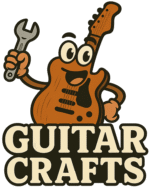When your electric guitar kit build is finally complete, there’s still one critical step before you can call it “ready to rock” — adjusting action and intonation on your newly built guitar. This fine-tuning process is what takes your instrument from just playable to feeling like a professional setup. Action and intonation directly affect how comfortable your guitar is to play and how accurately it stays in tune across the fretboard, making them essential finishing touches for any DIY guitar build.
Introduction to Guitar Setup: Finding Your Sound
A guitar’s setup is the bridge between construction and performance. Even if you’ve nailed your fretwork, wiring, and finishing, poor action or intonation can make your guitar feel clumsy and sound out of tune. Proper setup ensures your guitar plays easily, sounds clear, and stays in tune no matter where you are on the neck.
Action refers to the height of your strings above the fretboard, which influences both playability and tone. Intonation is the calibration that ensures each fret produces the correct pitch. Both need to work in harmony for your guitar to feel “right.”
If you haven’t already gone through other core adjustments, see How to Properly Set Up Your Electric Guitar Kit for Intonation and Setting Up the Bridge and Neck on Your Electric Guitar Kit for deeper setup foundations.
Importance of Setting Action and Intonation
- Sound Quality – Poor intonation makes even perfectly fingered chords sound off.
- Playability – Action that’s too high wears out your fingers; too low causes fret buzz.
- Tone Control – Both settings can subtly change sustain, clarity, and feel.
For a smoother playing experience, these two adjustments should be made with care and in sequence.
Step-by-Step Guide: Should I Adjust Action or Intonation First?
Many luthiers recommend adjusting action before intonation, and here’s why:
- Changing the action alters string length and tension slightly, which will throw off intonation if done afterward.
- Lowering action can make notes go sharp if intonation is already set.
However, there are exceptions:
- If the intonation is wildly off after string installation, a preliminary intonation check can help spot underlying issues (like incorrect string gauge or bridge placement).
- In most cases, though, action comes first, followed by intonation for best results.
** Here’s a little transparency: Our website contains affiliate links. This means if you click and make a purchase, we may receive a small commission. Don’t worry, there’s no extra cost to you. It’s a simple way you can support our mission to bring you quality content. **
As an Amazon Associate, I earn from qualifying purchases.
Detailed Process: Adjusting Your Guitar’s Action
Tools Needed:
- Allen wrench or screwdriver (depending on your bridge type)
- String action ruler or feeler gauge
- Fresh set of strings
Step-by-Step:
- Tune to Pitch – Always set action with your guitar in standard tuning.
- Measure String Height – Measure at the 12th fret from the top of the fret to the bottom of the string.
- Adjust Bridge Saddles – Raise or lower using your bridge’s adjustment screws.
- Re-tune & Re-check – Small changes in action will alter tuning; always re-tune before re-measuring.
- Test for Buzz – Play every fret on each string to check for buzzing or dead spots.
📌 Note: Adjusting action will impact intonation — so expect to fine-tune intonation afterward. For bridge-related guidance, check Setting Up the Bridge and Neck on Your Electric Guitar Kit.
Mastering the Basics: How to Adjust Guitar Intonation
Equipment:
- High-accuracy tuner (clip-on or pedal)
- Screwdriver for saddle adjustments
Steps:
- Tune Open String – Make sure the open string is perfectly in tune.
- Check at 12th Fret – Play the 12th fret note and compare to the open string.
- Adjust Saddles –
-
- If the 12th fret note is sharp, move the saddle back (increase string length).
- If flat, move the saddle forward (shorten string length).
- Re-Tune & Repeat – Check after every adjustment.
Common Mistakes to Avoid:
- Not checking tuning after each saddle move.
- Using worn-out strings — intonation should always be set with fresh strings.
- Forgetting temperature/humidity effects; wood can move slightly.
If you’re upgrading electronics during your setup, see Guide to Wiring Your Electric Guitar Kit for Optimal Performance for wiring optimization tips that pair well with a good setup.
How Intonation Adjustments Enhance Guitar Performance
Proper intonation:
- Keeps chords in tune up and down the neck.
- Improves harmonic richness.
- Makes bending and vibrato sound more natural.
- Prevents the “out of tune” sound on higher frets.
Fine Tuning: Getting Your New Guitar to Perfection
Once action and intonation are dialed in:
- Check Neck Relief – See How to Adjust Truss Rod for Neck Relief in Guitar Kits.
- Inspect Pickup Height – Balanced pickups will match your new setup’s clarity; see Adjusting Pickup Height for Optimal Sound on Your Guitar.
- Lubricate the Nut – Reduces friction and tuning instability.
Maintenance Tips:
- Re-check setup seasonally or after major climate changes.
- Change strings regularly — old strings throw off intonation.
- Keep tools handy for small tweaks.
Final Thoughts…
Adjusting action and intonation on your newly built guitar is one of the most rewarding parts of the build process — it’s when your hard work starts to sing. With careful adjustments, regular maintenance, and a little patience, your guitar will not only play like a dream but also sound exactly the way you imagined when you first started building it.
There are 100’s of ways you can build a business around your passion for guitar building.
Check it out…



This is such a helpful and timely guide! You really nailed why action and intonation are the final, most critical steps in transforming a guitar kit from “assembled” to “performance-ready.” Making that clear distinction—the action comes first, then intonation—helps anyone setting up their instrument avoid frustrating rework. I especially appreciated how you walked through measuring string height at the 12th fret, adjusting saddle position, and the importance of re-tuning after every tweak. That advice about testing for fret buzz afterward is golden—it ensures that the setup isn’t just precise but also comfortable to play. The way you explained the subtle shifts in tension and pitch between action and intonation felt both practical and grounded in real experience.
Do you find certain kits or bridge types—say, Tune-o-Matic vs. Strat-style tremolo—present unique challenges when dialing in both action and intonation?
Thanks so much! I’m really glad the guide came across as both practical and usable. It’s amazing how much those final setup steps can make a kit feel like a “real” guitar. And yes, different bridge types definitely have their quirks. A Tune-o-Matic can be pretty straightforward for intonation, but action tweaks sometimes require a bit more compromise across the fretboard. Strat-style tremolos give you more granular control, but they can also be more finicky since spring tension and bridge angle come into play. In both cases, patience (and a good tuner) is your best friend.
Thanks again.
~Wayne
Great breakdown! I like how you explained the order of adjustments — setting action before intonation — since that’s a point that can confuse a lot of first-time builders. The step-by-step guides make it really approachable, especially with the reminders to re-tune and use fresh strings.
One question: when setting action on a new kit build, do you recommend sticking to standard “factory spec” measurements at first, or is it better to tailor the setup immediately to the player’s personal style (like lower action for fast playing vs. higher for heavy strumming)?
Really glad you found the step-by-step breakdown helpful! That’s a great question. For a fresh kit build, I usually suggest starting with factory spec measurements first. They give you a reliable baseline that ensures the guitar plays cleanly without buzz, and it’s easier to troubleshoot if something feels off. Once everything is stable at that point, you can fine-tune the action to match the player’s style—whether that’s a lower setup for speed or a slightly higher one for heavier strumming.
Think of factory specs as the “safe starting zone,” and personal tweaks as the fun part that makes the guitar truly yours.
Thanks so much!
~Wayne